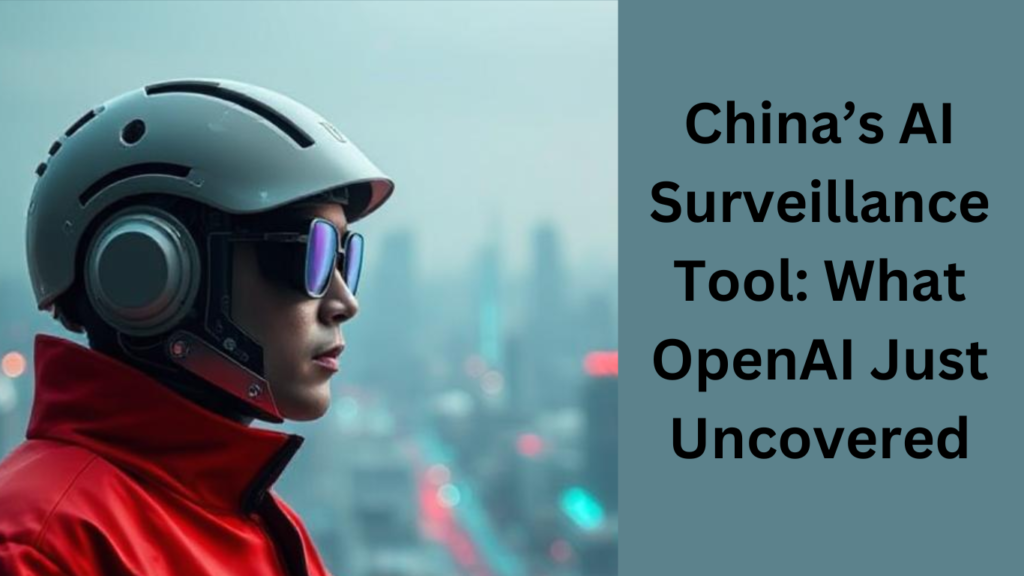China’s AI Surveillance Tool: What OpenAI Just Uncovered

Introduction
Artificial intelligence is reshaping the way governments monitor online activity. A recent discovery by OpenAI has revealed an AI-powered surveillance system linked to China that tracks anti-China sentiments on Western social media platforms. This shocking revelation raises serious concerns about privacy, free speech, and the future of AI-driven surveillance. This blog breaks down how this system operates, who is behind it, and what it means for global online security.
How OpenAI Discovered the AI Surveillance Tool
OpenAI stumbled upon the surveillance system, code-named Peer Review, when a developer working on it accidentally used OpenAI’s chatbot to debug part of its code. This slip exposed the AI’s actual purpose – monitoring, tracking, and analyzing posts critical of the Chinese government across various Western social media platforms.
Cybersecurity expert Robert Potter, who helped analyze the tool, discovered that it was tracking 2.2 million people, including 35,000 Australians. If this tool was found by accident, it raises an alarming question: How many other AI-driven surveillance programs exist that remain undetected?
How the AI System Works
China’s AI surveillance system operates through real-time sentiment analysis using machine learning algorithms. Here’s how it functions:
- Keyword and Sentiment Tracking: The AI scans social media posts, filtering content based on keywords and patterns associated with anti-China rhetoric.
- Real-Time Monitoring: It continuously collects data, tracking discussions and trends.
- User Categorization: The system organizes individuals based on their online behavior, potentially flagging them for further monitoring.
- Llama-Based AI Model: This AI system is built using Meta’s Llama, an open-source AI model originally designed for innovation but now repurposed for government-backed surveillance.
Who is Being Monitored?
According to OpenAI’s investigation, millions of users across Western countries are unknowingly under surveillance. The system focuses on:
- Activists and Journalists: Individuals reporting on Chinese policies.
- Political Figures: Officials discussing China-related policies.
- Regular Social Media Users: Anyone engaging in discussions critical of China.
The most concerning aspect? This is not passive monitoring. The AI actively aggregates data to provide the Chinese government with insights into trending global conversations.
China’s Expanding AI Surveillance Efforts
China has long been known for its strict digital surveillance policies. However, this marks a shift towards global AI-driven monitoring, extending beyond its borders.
China has already implemented AI-driven surveillance domestically, including:
- Facial Recognition Systems: Used extensively to monitor citizens in real-time.
- Social Credit System: Tracks citizens’ online and offline behavior, influencing their social privileges.
- State-Controlled Censorship: Platforms like WeChat and TikTok are monitored for political discourse.
Now, these tactics are expanding globally, raising ethical concerns about AI as a tool for international surveillance and propaganda.
Other Cases of AI Misuse in Global Politics
OpenAI’s findings reveal that China is not alone in leveraging AI for political influence. Other alarming cases include:
- Sponsored Discontent: AI-generated content is being used to spread misinformation about Chinese dissidents. The system translates and distributes manipulated narratives worldwide, particularly in Spanish-speaking communities.
- Political Propaganda: AI-generated posts aimed at shaping public opinion have been identified, targeting Western political discussions.
- Financial Scams: AI-driven fraud schemes, like the Pig Butchering technique, trick victims into fraudulent investments.
This highlights a larger trend – AI is not just a tool for innovation; it is being weaponized for political and economic gain.
The Future of AI Surveillance
If AI surveillance tools like Peer Review exist today, what does the future hold? The next generation of AI surveillance could include:
- Predictive Monitoring: AI models capable of predicting and suppressing political movements before they gain traction.
- Deepfake Propaganda: AI-generated deepfake videos used for political manipulation.
- AI-Driven Censorship: Governments restricting access to certain content based on AI-generated insights.
- Mass Biometric Data Collection: AI tools tracking personal data, including health metrics and location.
These developments could lead to an AI arms race, where governments worldwide develop increasingly sophisticated AI surveillance tools.
What Can Be Done?
1. Stronger AI Regulations
Governments and organizations must establish strict policies on AI development and usage to prevent its misuse for surveillance and censorship.
2. Transparency in AI Development
Big tech companies like Meta, OpenAI, and Google should implement transparency policies, ensuring their AI models are not misused for government-backed monitoring.
3. User Awareness and Digital Privacy Tools
Individuals should take measures to protect their online privacy, such as:
- Using end-to-end encrypted messaging apps
- Avoiding sharing personal data on public forums
- Using VPNs and privacy-focused browsers
4. Global AI Ethics Discussions
AI ethics panels and discussions should be prioritized in international forums to prevent authoritarian AI from becoming the norm.
Conclusion
OpenAI’s discovery of China’s AI-powered surveillance tool is a wake-up call. AI is rapidly transforming the landscape of global surveillance, and without proper regulations, it could lead to a world where privacy no longer exists. As technology advances, individuals, businesses, and governments must take steps to ensure AI remains a tool for progress rather than control.
FAQs
- What is China’s AI surveillance tool?
- It is an AI-powered monitoring system that tracks and analyzes anti-China discussions on Western social media platforms.
- How did OpenAI discover this AI surveillance tool?
- A developer mistakenly used OpenAI’s chatbot to debug code, revealing the tool’s purpose.
- Who is being tracked by this AI surveillance system?
- Millions of social media users, including activists, journalists, and political figures.
- How does the AI surveillance system work?
- It scans posts in real-time, detecting sentiment, keywords, and trends critical of China.
- Can AI surveillance be prevented?
- Stronger regulations, transparency, and digital privacy measures can help mitigate AI surveillance risks.